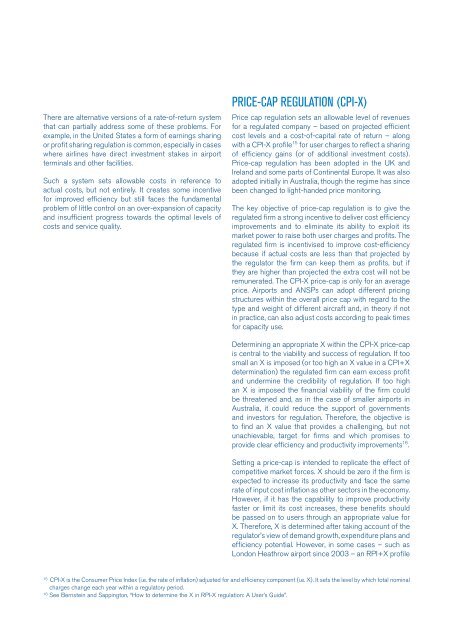Economic Regulation - IATA
Economic Regulation - IATA
Economic Regulation - IATA
You also want an ePaper? Increase the reach of your titles
YUMPU automatically turns print PDFs into web optimized ePapers that Google loves.
There are alternative versions of a rate-of-return system<br />
that can partially address some of these problems. For<br />
example, in the United States a form of earnings sharing<br />
or profit sharing regulation is common, especially in cases<br />
where airlines have direct investment stakes in airport<br />
terminals and other facilities.<br />
Such a system sets allowable costs in reference to<br />
actual costs, but not entirely. It creates some incentive<br />
for improved efficiency but still faces the fundamental<br />
problem of little control on an over-expansion of capacity<br />
and insufficient progress towards the optimal levels of<br />
costs and service quality.<br />
PRICE-CAP REGULATION (CPI-X)<br />
Price cap regulation sets an allowable level of revenues<br />
for a regulated company – based on projected efficient<br />
cost levels and a cost-of-capital rate of return – along<br />
with a CPI-X profile 15 for user charges to reflect a sharing<br />
of efficiency gains (or of additional investment costs).<br />
Price-cap regulation has been adopted in the UK and<br />
Ireland and some parts of Continental Europe. It was also<br />
adopted initially in Australia, though the regime has since<br />
been changed to light-handed price monitoring.<br />
The key objective of price-cap regulation is to give the<br />
regulated firm a strong incentive to deliver cost efficiency<br />
improvements and to eliminate its ability to exploit its<br />
market power to raise both user charges and profits. The<br />
regulated firm is incentivised to improve cost-efficiency<br />
because if actual costs are less than that projected by<br />
the regulator the firm can keep them as profits, but if<br />
they are higher than projected the extra cost will not be<br />
remunerated. The CPI-X price-cap is only for an average<br />
price. Airports and ANSPs can adopt different pricing<br />
structures within the overall price cap with regard to the<br />
type and weight of different aircraft and, in theory if not<br />
in practice, can also adjust costs according to peak times<br />
for capacity use.<br />
Determining an appropriate X within the CPI-X price-cap<br />
is central to the viability and success of regulation. If too<br />
small an X is imposed (or too high an X value in a CPI+X<br />
determination) the regulated firm can earn excess profit<br />
and undermine the credibility of regulation. If too high<br />
an X is imposed the financial viability of the firm could<br />
be threatened and, as in the case of smaller airports in<br />
Australia, it could reduce the support of governments<br />
and investors for regulation. Therefore, the objective is<br />
to find an X value that provides a challenging, but not<br />
unachievable, target for firms and which promises to<br />
provide clear efficiency and productivity improvements 16 .<br />
Setting a price-cap is intended to replicate the effect of<br />
competitive market forces. X should be zero if the firm is<br />
expected to increase its productivity and face the same<br />
rate of input cost inflation as other sectors in the economy.<br />
However, if it has the capability to improve productivity<br />
faster or limit its cost increases, these benefits should<br />
be passed on to users through an appropriate value for<br />
X. Therefore, X is determined after taking account of the<br />
regulator’s view of demand growth, expenditure plans and<br />
efficiency potential. However, in some cases – such as<br />
London Heathrow airport since 2003 – an RPI+X profile<br />
15<br />
CPI-X is the Consumer Price Index (i.e. the rate of inflation) adjusted for and efficiency component (i.e. X). It sets the level by which total nominal<br />
charges change each year within a regulatory period.<br />
16<br />
See Bernstein and Sappington, “How to determine the X in RPI-X regulation: A User’s Guide”.

















